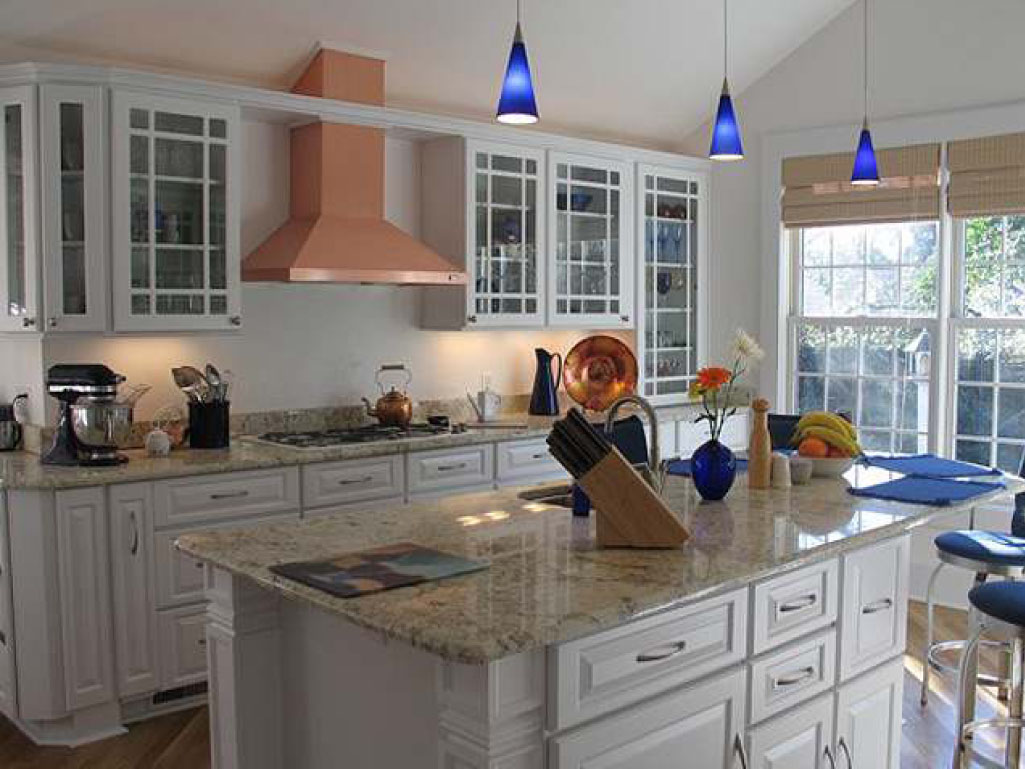It’s important to choose hardware that will complement the rest of your kitchen décor and accentuate its worthy features. Generally, most people want their cabinet and drawer hardware to coordinate with the handles on their appliances. The colors should work well together, and the finishes shouldn’t clash. Drastically different shapes can also make your kitchen feel cluttered.
You should use functionality and your personal preference to approach choosing knobs vs. pulls, but there are a few general guidelines to follow that correlate with your style of cabinets:
- Shaker style cabinets. The most common style of cabinet offers flexibility in design, and they work well with knobs or cup or bin pulls. Shakers are known for their simplicity and clean lines, so simple hardware is often used, such as round knobs.Traditional nickel or steel knobs or pulls are common, as well as vintage glass or ceramic knobs. Vintage pulls with exposed screws provide a classic touch or industrial feel to a new kitchen with shaker cabinets. Tubular bar pulls — which can be short or long and dramatic — modernize a traditional kitchen with shaker cabinets. Flat bar pulls offer a contemporary edge, while wire pulls keep your décor traditional. Arched and footed bar pulls offer a classic look on shaker style cabinets.
- Flat-panel cabinets.Most often seen in modern or contemporary kitchens, flat-panel cabinets embrace minimal embellishment to focus on natural materials. Subtle hardware choices are best, such as stainless steel bar pulls. You often see long, extended versions placed on the door or drawer.If you prefer square edges, you can choose a flat bar pull. Recessed pulls offer a functional option that work especially well for high-traffic kitchens. If you’re aiming for a minimalist look to your kitchen, you might consider discreet tab pulls for your flat-style cabinets.
- Inset cabinets. Inset cabinets offer flush, inset doors with an edge detail that evokes fine craftsmanship. Many insets have exposed hinges, giving you something else to consider as most people prefer knobs or pulls to match them. Both pulls and knobs are often paired with inset cabinets.
- Distressed cabinets. Rustic hardware pairs nicely with distressed cabinets. Consider adding back plates for a Mediterranean style, rustic or antique knobs, or sandcast bronze pulls.
- Louvered cabinets. Both pulls and knobs work with louvered kitchen cabinets, but knobs are most common. Keep in mind louvered cabinets have more detail than a plain, solid cabinet. There’s more to look at, so they naturally require more attention, which is why many people choose simple or classic knobs or pulls to complement louvered cabinets.
- Beadboard cabinets. These cabinets offer a cottage chic look, which pairs nicely with knobs and cup pulls. Like louvered cabinets, there’s more detail to view, so simple hardware tends to work best. Adding elaborate hardware might be too distracting and take away from the character of the beadboard.
Ultimately, you should choose your hardware according to your personal preferences, kitchen style and goals for functionality. If you’re concerned about resale value, recognize that the most popular hardware finishes are satin, nickel and bronze. There are no hard-set rules to follow when it comes to adding the final details to your kitchen, and many people choose a combination of knobs and pulls. If you’re unsure of which to choose for your kitchen cabinets or drawers, it’s wise to examine the pros and cons of both.
Knobs or Pulls:
The Pros and Cons – The choice between cabinet pulls and knobs isn’t easy — both come with positives and negatives. Keep in mind that you’ll be using your knobs or pulls every day. Whatever you choose should feel natural in your hand and flow with the décor of the room. You should consider your kitchen’s décor and style, the look you want to achieve, your budget, ease of cleaning, ease of use, the weight of your drawers and more.

